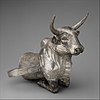lingvo.wikisort.org - Language
Palaic is an extinct Indo-European language, attested in cuneiform tablets in Bronze Age Hattusa, the capital of the Hittites. Palaic, which was apparently spoken mainly in northern Anatolia, is generally considered to be one of four primary sub-divisions of the Anatolian languages, alongside Hittite (central Anatolia), Luwic (southern Anatolia) and Lydian (western Anatolia).
| Palaic | |
|---|---|
| Region | Anatolia |
| Ethnicity | Palaic peoples |
| Extinct | around 1300 BCE |
Language family | Indo-European
|
| Language codes | |
| ISO 639-3 | plq |
Linguist List | plq |
| Glottolog | pala1331 |
Its name in Hittite is palaumnili, or "of the people of Pala"; Pala was probably to the northwest of the Hittite core area, so in the northwest of present mainland Turkey. The region was overrun by the Kaskians in the 15th century BC, and the language likely went out of daily use at that time.
Sources
The entire corpus of Palaic spans only CTH 751-754 in Emmanuel Laroche's catalog of Hittite texts; in addition Hittite texts elsewhere cite passages in Palaic in reference to the weather god Zaparwa (Hittite Ziparwa), the leading God of the land of Pala.[1][2] In particular, CTH 750, a festival in Hittite for Ziparwa and associated deities, includes passages stating, "The Old Woman speaks the words of the bread in Palaic," or alternately "the words of the meal," though no Palaic passages are quoted. The Palaic-language texts are all from a religious context, with ritual and mythological content.[3] In addition to Zaparwa, the Palaumnili-speakers worshipped a sun deity Tiyaz (Luwian Tiwaz), the Hattian goddess Kataḫzip/wuri, and several others.
Morphology
In terms of its morphology, Palaic is a fairly typical specimen of Indo-European. Old Hittite has the genitive singular suffix -aš circa 1600 BC (compare Proto-Indo-European *-os); where Cuneiform Luwian instead uses the -ašša/i- adjectival suffix. Palaic, on the northern border of both, like later Hieroglyphic Luwian has both an -aš genitive and an -aša- adjectival suffix. Palaic also shows the same gender distinction as seen in Hittite, i.e. animate vs. inanimate; and has similar pronoun forms.
References
- Burney, Charles (2004). Historical Dictionary of the Hittites. Scarecrow Press. p. 223. ISBN 0810865645.
- Kloekhorst, Alwin (2022). "Anatolian". The Indo-European Language Family. pp. 63–82. doi:10.1017/9781108758666.005. ISBN 978-1-108-75866-6.
- Carruba, O. Das Palaische. Texte, Grammatik, Lexikon. Wiesbaden: Harrassowitz, 1970. StBoT 10.
Further reading
- Sasseville, David; Görke, Susanne (2021). "Palaisch. Eine indogermanische Kleinkorpussprache in Zentralanatolien". Antike Welt.
- Melchert, H. Craig (1984). "Notes on Palaic". Zeitschrift für vergleichende Sprachforschung. 97 (1): 22–43. JSTOR 40848728.
- Melchert, H. Craig (2008). "Palaic". The Ancient Languages of Asia Minor. pp. 40–45. doi:10.1017/CBO9780511486845.007. ISBN 978-0-521-68496-5.
- Sasseville, David; Yakubovich, Ilya (2018). "Palaic Words for Domestic Animals and their Enclosures". Historische Sprachforschung. 131: 46–58. JSTOR 27032358.
- Sasseville, David (10 July 2019). "'To show' in Hittite and Palaic Rituals". Altorientalische Forschungen. 46 (1): 22–32. doi:10.1515/aofo-2019-0003. S2CID 198490660.
External links
- "Digital etymological-philological Dictionary of the Ancient Anatolian Corpus Languages (eDiAna)". Ludwig-Maximilians-Universität München. Archived from the original on 2017-02-25. Retrieved 2017-03-14.
- Catalog of Hittite Texts
- Genitive Case and Possessive Adjective in Anatolian by Craig Melchert
На других языках
[de] Palaische Sprache
Das Palaische (heth. palaumnili) wurde im 2. Jahrtausend v. Chr. im nördlichen Anatolien gesprochen, in der Region Pala, nordwestlich vom hethitischen Kernland, und gehörte zu den anatolischen Sprachen, einer Untergruppe der indogermanischen Sprachen. Es kam spätestens im 13. Jahrhundert v. Chr. außer Gebrauch.- [en] Palaic language
[fr] Palaïte
Le palaïte est une langue indo-européenne, appartenant au groupe anatolien, par un peuple désignés aussi sous le nom de Palaïte dans la région appelée Pala par les textes hittites. Ce nom est apparenté à celui de Palestine et de Philistin.[it] Lingua palaica
Il palaico è una lingua indoeuropea estinta, appartenente alla famiglia delle lingue anatoliche, attestata in tavolette incise con caratteri cuneiformi ad Ḫattuša. Il nome della lingua in ittita era palaumnili, o "del popolo di Pala"; Pala si trovava probabilmente a nord-ovest della zona di insediamento centrale degli ittiti, perciò nel nord-ovest dell'odierna Turchia continentale. La regione venne conquistata dai barbari Kaska verso la fine del XV secolo a.C. e con molta probabilità la lingua si estinse poco dopo quel periodo.[ru] Палайский язык
Пала́йский язы́к — вымерший малоазийский язык, принадлежавший к анатолийской ветви индоевропейских языков. Засвидетельствован в ритуальных клинописных текстах XVII—XIV веков до н. э., найденных в Хаттусе — столице Хеттского царства[1]. Сохранившиеся тексты преимущественно использовались в культе божества Ципарфы (Цапарфы), заимствованного хеттами из хаттского пантеона[1].Другой контент может иметь иную лицензию. Перед использованием материалов сайта WikiSort.org внимательно изучите правила лицензирования конкретных элементов наполнения сайта.
WikiSort.org - проект по пересортировке и дополнению контента Википедии
